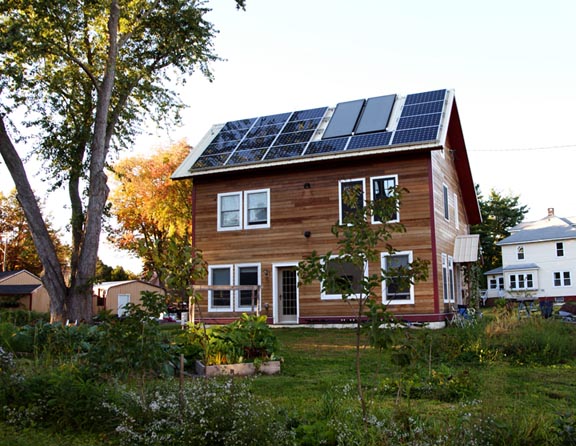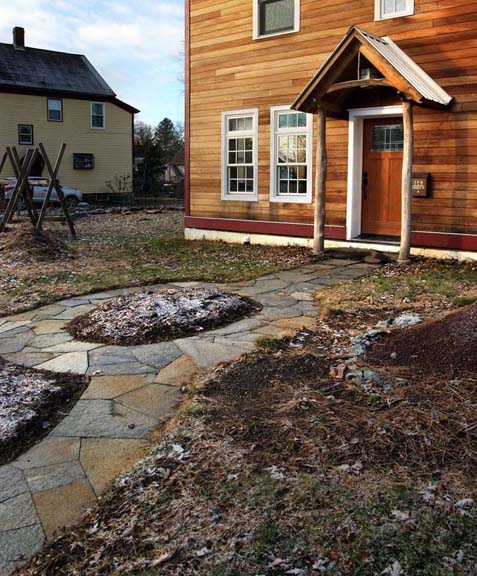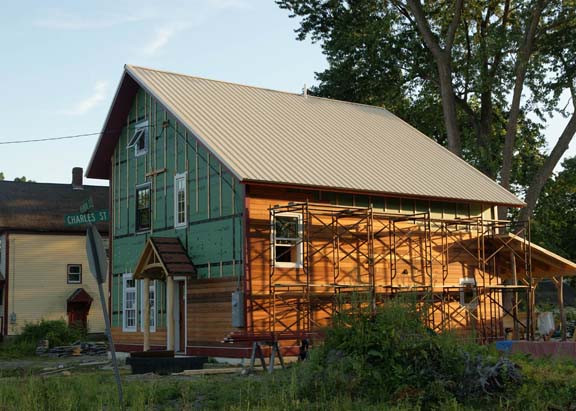Project Description:
"If you stop by Spartan and Hannah’s 1500 square foot home on a sunny January afternoon, you will find yourself surrounded by warmth. This isn’t because of a wood stove, or a sophisticated heating system—in fact, you will probably find that the only heat source for the house, a 12kbtu heat pump, will be off. The house will be 70 degrees through a successful combination of passive solar design and super-insulation.
Spartan and Hannah’s home doesn’t just perform under sunny conditions. True testimony to its energy efficiency can be found in data logged. Last winter the average indoor temperature was 68 degrees. At the same time, the heat pump used a mere $190 worth of electricity. Also, during the first year of operation, the 4.5 kW PV system produced a 500kW surplus; easily securing a net-positive title for the all-electric home.
Today, to construct a net zero home, builders need simply to follow “The Formula”: insulate using the R20-40-60 rule, get the ACH50 below .6, use triple pane windows, and install a 5-10 kW PV system. The question before us now is how to bring down costs, get by with a smaller PV system, and, perhaps most importantly and most frequently overlooked, decrease the energy needed to create the building.
We answered the call to improve upon The Formula not through any single measure, but through a myriad of small design solutions, most of which, like passive solar, incur little or no additional cost. Several examples follow.
A saltbox shape allows all living spaces to have south-facing glass while keeping volume low and minimizing exterior surface area. The volume of conditioned space can be further decreased by closing an air-tight door to the mudroom and adjoining pantry. An open floor plan and an air space opening between the two floors allow heat to easily rise up to the second floor. The air space between floors doubles as the location of an elegant builtin
laundry drying rack and thus there is no need for a dryer. These and many more design solutions reduce our energy load and allow us to “get away with” a relatively small PV system, just one air source heat pump, and double pane windows.
As important as it is to decrease the operational costs of a building, we would like to highlight the often overlooked embodied energy of construction. Throughout construction, we made an effort to use recycled or secondmarket product, and to decrease the use of heavy carbon footprint materials like concrete, aluminum, drywall, and foam. To this end, all of our foundation foam-board was recycled and most of our doors and windows and many other materials were purchased from second-market sources like Craigslist. Also, in order to reduce concrete, we engineered a shallow, frost protected foundation with a narrow 6” frost wall.
Spartan and Hannah’s home demonstrates ways to move beyond “The Formula.” Rather than adding another kilowatt of PV or elaborate technology, simple design choices reduce the energy footprint of our home. In order to help others learn about these ideas, our blog documents the entire building process, including performance data for the previous three years."
Address:
Elevation:
Lat. / Long.:
Location Type:
Köppen Climate Type:
Climate Region:
Solar Insolation:
Annual HDD :
Annual CDD:
HDD Base Temp:
CDD Base Temp:
Occupancy Type and Details:
3 Person Family, 1083 Person Days of Occupancy
Conditioned Floor Area:
Conditioned Building Volume:
Multiple buildings?:
Historic?:
Site description:
Quarter acre lot in Greenfield, MA. Land needed to be cleared.
Materials:
Sheathing: Zip Wall and Roof. Siding" Western Red Cedar, T&G, 1x6. Roof: Exposed fastener ribbed metal, ivory. Exterior Trim: Cypress, except for soffit which is pine. Flooring 1st Floor: Scrap stone countertop. Flooring 2nd Floor: Spruce 2x6, T&G. Ceilings: Lightrock Drywall 50% and #3 T&G Grade pine 50%. Porch Deck: Pressure treated southern pine. Porch and entryway: Local Black Locust.
Energy Highlights:
House is 100% Electric
Annual renewable energy generated:
Electric Utility Company:
Gas Utility Company:
Electricity amount (imported from grid):
Electricity amount (credited or exported to grid):
Net electricity usage (purchased electricity):
Foundation wall assembly:
2" exterior 4" interior 6" XPS
Above grade wall assembly:
double stud connected by gussets 24" O.C. mixture of platform and balloon framing, 12.5" dense pack cellulose
Cathedral ceiling assembly:
26" Cellulose North, 21" Cellulose South
Door Area:
Space heating - Manufacturer & Model:
Space cooling - Manufacturer & Model:
Domestic hot water - Manufacturer & Model:
Domestic hot water - capacity:
Ventilation - Manufacturer & Model:
Process:
"Spartan and Hannah’s home demonstrates ways to move beyond 'The Formula.' Rather than adding another kilowatt of PV or elaborate technology, simple design choices reduce the energy footprint of our home. In order to help others learn about these ideas, our blog documents the entire building process, including performance data for the previous three years."
Finances Description:
"The total cost of construction from clearing land until we were able to move in was about $160,600. This doesn't include the $60,000 to purchase the quarter acre lot. This final cost also does not include Spartan Giordano’s full time labor, which, because he was working for himself, was not tallied. We received $15,100 in rebates and tax incentives bringing the total cost down to $145,500. Using the 145 number, our 1500 square foot house cost $97/SF to build."
Total Cost of Project:
Construction hard cost:
Value of Tax Credits for renewable energy systems:
NESEA Awards:
2015 Zero Net Energy Building Award Winner
Special architectural measures:
Passive design allows home to be 100% solar heated on sunny winter days. Indoor build-in laundry drying eliminates need for dryer. Open floor plan with additional opening between floors hot air from heat pump to convect to second floor. Large deciduous tree on west side of house reduces cooling load but has minimal impact on wintertime solar gain or roof solar access. Air Intake for HRV on southern wall to take advantage of sun. Heat pump condenser located on southwest corner to improve energy efficiency. White roof reduces cooling load. Advanced framing strategies reduced wood content of exterior walls to 8.3%. Mudroom and pantry are airsealed from the home, so with the door shut the conditioned volume drops by about 550 cubic feet.
Energy Use and Production Documentation:
Slab edge R-value:
Foundation wall R-value:
Above grade wall R-value:
Cathedral ceiling R-value:
Average window U-factor:
Door U-Factor:
Cost per square foot of Conditioned Space:
Air Changes per hour, ACH50:
Project Photos:





Scope Description:
32'x26' Saltbox Style 2 Floor Home
Site conditions:
Renewable Energy Sources:
Other Purchased Fuels Description:
None - House is 100% Electric
Summary of enclosure strategy/description:
Double Stud connected by gussets, parallel chord trusses, vented cathedral ceiling
Roof Assembly:
Parallel chord trusses, vented cathedral ceiling, 24" O.C., Southern pitch 45 degrees, northern pitch 35 degrees
Roof R-value:
Window Description:
Mix of Andersen, Marvin, Marvin integrity and Serious. All double pane except Serious, mostly double hung
Door Description:
Thermatru fiberglass XPS core, and simpson solid wood
